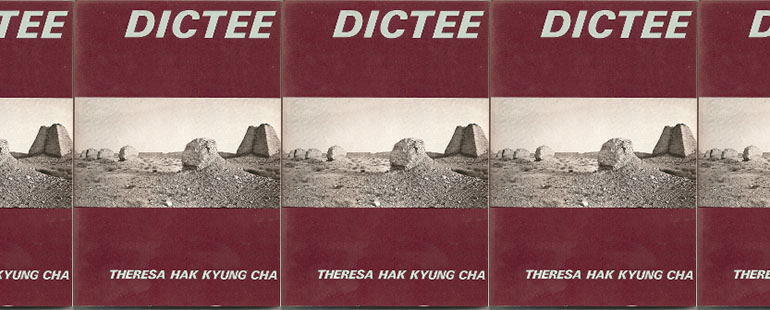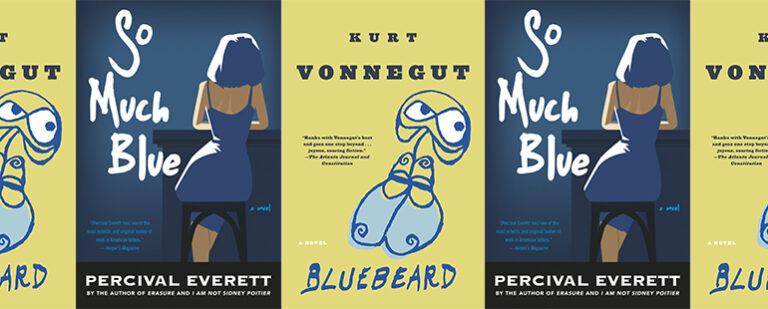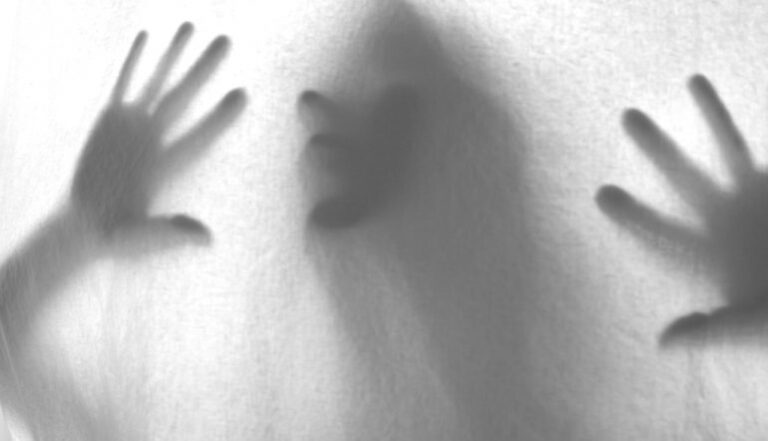The Art of Conversation in Theresa Hak Kyung Cha’s Dictee

Recently, I was invited to coffee with Jo-ey Tang, the Columbus College of Art and Design’s Director of Exhibitions, and visiting German artist Heide Hinrichs—because, Tang said, “I think you two should meet.” I was flattered, but also a little terrified. Teaching at an art and design school, as I do, is great in theory, but it means exposing my ignorance on a semi-regular basis. Sure, I took a bunch of art history classes as an undergraduate, and I consider myself a serious fan of visual art works, but there’s a lot I don’t know, and that leaves me, at times, in a paralyzing state of intellectual FOMO.
The night before the meeting, I frantically Googled Hinrichs, hoping that by looking at her work I might have something halfway intelligent to say to her. As it turns out, she is concerned with learning, too, but the fear she describes around that learning has less to do with her own ignorance and more to do with how knowledge is disseminated, how it’s made available, and to whom. Hinrichs’ Second Shelf Project aims to bring books by and about queer artists, artists of color, nonbinary and women artists, and other underrepresented voices into college and university libraries—an effort that began with her home institution in Brussels. As a way of introducing me to her dilemma, she said to me, “I was amazed to find there weren’t any books on Agnes Martin!” I felt myself relax a bit. I know who Agnes Martin is.
Then, the conversation turned to a name I didn’t recognize—Theresa Hak Kyung Cha—a Korean American artist and writer who was deeply influenced by a particular method of film analysis: she would watch one frame at a time. “You should do that with your students,” Hinrichs said. “I think they’d kill me,” I told her, but Hinrichs couldn’t stop smiling. “Imagine,” she enthused, “one film all semester, frame by frame, image by image! What do you think you’d talk about? Where do you think the conversation would go?”
Hinrichs has been in conversation with other artists for many years now; she aims to record her responses to their work—and in that work, she finds responses to others’ work. We know objectively that this is how knowledge accumulates, a method applicable to both monks illuminating manuscripts and to students bent over books in a college library. It’s all about conversation—between artists and writers, between readers and books, between one floor of a building and another, between galleries and libraries.
The evocation of Cha’s name seemed to me to be evoked in reverence, as representative of this kind of communion. Cha’s work, specifically her 1982 book Dictee, is both academic and emotionally present, theoretical and practical. It eschews easy classification, and is influenced by filmmakers as much as it is by playwrights, visual artists, poets, and critics. How had I never heard of this woman before? I felt my inner-neophyte start to panic, but Hinrichs and Tang seemed genuinely excited for me to know her, to learn about her. This is the nature of conversation, this is why it exists, why certain magical things happen when people get together to talk about art and ideas. This, indeed, is what the Second Shelf Project is all about.
For Cha, the exchange opens up to include conversation between generations, between traumas, between countries, between God and His faithful, between images, between breaths. In Dictee, Cha is in conversation with not only with her mother, Hyung Soon Huo; nineteenth-century nun St. Thérèse of Lisieux; the Greek muses; and Korean activist Yu Guan Soon, but also with the genre conventions of memoir and poetry, history, film criticism, and the artist’s book.
Dictee confounds expectations at every turn. Specifically, there’s something monumental about the text’s extreme lack of metaphor, its striving toward objective observation, that feels to me—in this moment—absolutely poetic. Artist and critic Paul O’Kane describes her work as “communication [that] tries to sidestep the limitations of everyday speech in search of an Ur state that is neither local nor ‘global’, neither ancient, current nor futuristic, but which is untimely: a kind of speech that does not know from where or when it originates, that is innocent of what it intends, has no idea where and when it will be received, nor if it will ever be fully understood.” What Cha is aiming for, in other words, is expression drained of authorial authority, ego-less, open, and ready to receive transmission.
Perhaps it’s odd to think of critical writing or even creative writing in those terms. After all, the stereotypical professor is old, white, a man, and distinguished because of his original ideas, and the author’s imagination is autonomous. But Dictee, like Hinrichs’ Second Shelf, emphasizes the collaborative, communicative nature of criticism, applying (in Cha’s case) the multimodal qualities of film and theater, whose precursors are time-based rituals of oral storytelling, religious ceremony, and historical reenactment.
Cha, though, doesn’t evoke History with a capital “H” to express indisputable facts. What makes her so compelling is her emphasis, instead, on memory’s incorporeity. She writes, “Face to face with the memory, it misses. It’s missing. Still. What of time. Does not move. Remains there. Misses nothing. Time, that is. All else. All things else. All other, subject to time. Must answer to time, except. Still born. Aborted. Barely. Infant. Seed, germ, sprout, even less. Dormant. Stagnant. Missing.” What’s exempt from time—from History’s narrative—is that which has never been a part of the “official” narrative in the first place. Cha shows us, by employing the language of film analysis, that no matter how much we’d like to slow down the film and ruminate on individual images, no matter how close we get in “EXTREME CLOSE-UP,” so that the image of the face is divorced from the body, the body from narrative, the language from meaning—we’re no closer to capturing the character, the life, the essence of the lost person.
The act of looking at one cinematic frame—a single image—at a time reduces the desire to characterize the overarching story. Cha’s hyper-focus on the material facts of the event and almost devotional reverence for its details boils memory down to bio-mechanical processes. It’s not so much a matter of what a character says but, rather, the language she uses, or if she’s forbidden from using it, and the muscles of the face in the intake and outtake of breath:
Then you, as a viewer and guest, enter the house. It is you who are
entering to see her. Her portrait is seen through her things, that are hers.
The arrangement of her house is spare, delicate, subtly accentuating,
ing the words. She forms the words with her mouth as the other utter
across from her. She shapes her lips accordingly, gently she blows
whos and whys and whats. On verra. O-n. Ver-rah. Verre. Ah. On
verra-h. Si. S-i. She hears, we will see. If we will have to see if. If.
We would wait. Wait to see, We would have to wait and see, Wait and
See. If. For a second time. For another time. For the other overlapping
time.”
Cha utilizes her training in academic research and scholarly conversation in film in order to render memory, or, rather, to render the impossibility of memory—memory that eschews easy summary or sentimental evocation, stripping it of what Foucault calls souvenir, a concept Lauri Siisiäinen, in her book Foucault, Biopolitics, and Resistance, describes as “made of the dynamics of references, which does not become accomplished and consumed in any ‘souvenir’ through which the lost past would be recovered and made present once again.”
Memory doesn’t belong to one person, just as an idea doesn’t belong to one person. It is instead a collage, a hypertext, a collection of documents and images, quotes, and voices, of iteration, of democratically reproduced copies of letters, charts, and photographs that once clicked on, lead to more and more. In fact, Cha’s hard juxtaposition of intimate interior monologue, letters between government officials, grainy photos, and Xeroxed copies of handwritten notes works to simultaneously anonymize identity and individualize it. For example, in Dictee’s included photographs, faces become blanched and hard to discern. In monologues, voices are hard to differentiate. Is this Cha herself speaking, or her mother, or Yu Guan Soon, or St. Thérèse?
“I have the documents,” Cha writes, “Documents, proof, evidence, photograph, signature. One day you raise the right hand and you are American. They give you an American Pass port. The United States of America. Somewhere someone has taken my identity and replaced it with this photograph. The other one. Their signature their seals. Their own image.”
Identity, like memory, is mutable, ephemeral, at the whim of language and circumstance, and that disembodied absence, like the absence of color, is evoked again and again in Dictee: “She opens the cloth again. White. Whitest of beige. In the whiteness, subtle hues outlining phoenix from below phoenix from above facing each other in the weave barely appearing. Disappearing into the Whiteness.” Cha’s use of “whiteness” points to not only the white-washing of memory, but the degradation an image shows after multiple reproductions. In her essay “Diasporic Object Lessons,” Alison Fraser says, “Xerography has another political implication, one embraced by Cha: it both confronts the idea of the original or unique item, and puts the power of duplication and distribution (and therefore publication) into the hands of the individual, effectively presenting the opportunity to the general public to take roles previously held by editors and publishers, to the ire of those in traditional seats of power.”
For Cha, there’s a palpable tension between the process of assimilation and the desire to hold on to one’s memory of past places, identities, and languages. The conflict’s outcome, however, doesn’t seem to be the point. Cha seems instead interested in the conversation that happens when these two desires come in contact—the striving toward “wholeness,” if not its achievement, that occurs when we attempt, when we pay attention, one frame at a time.


